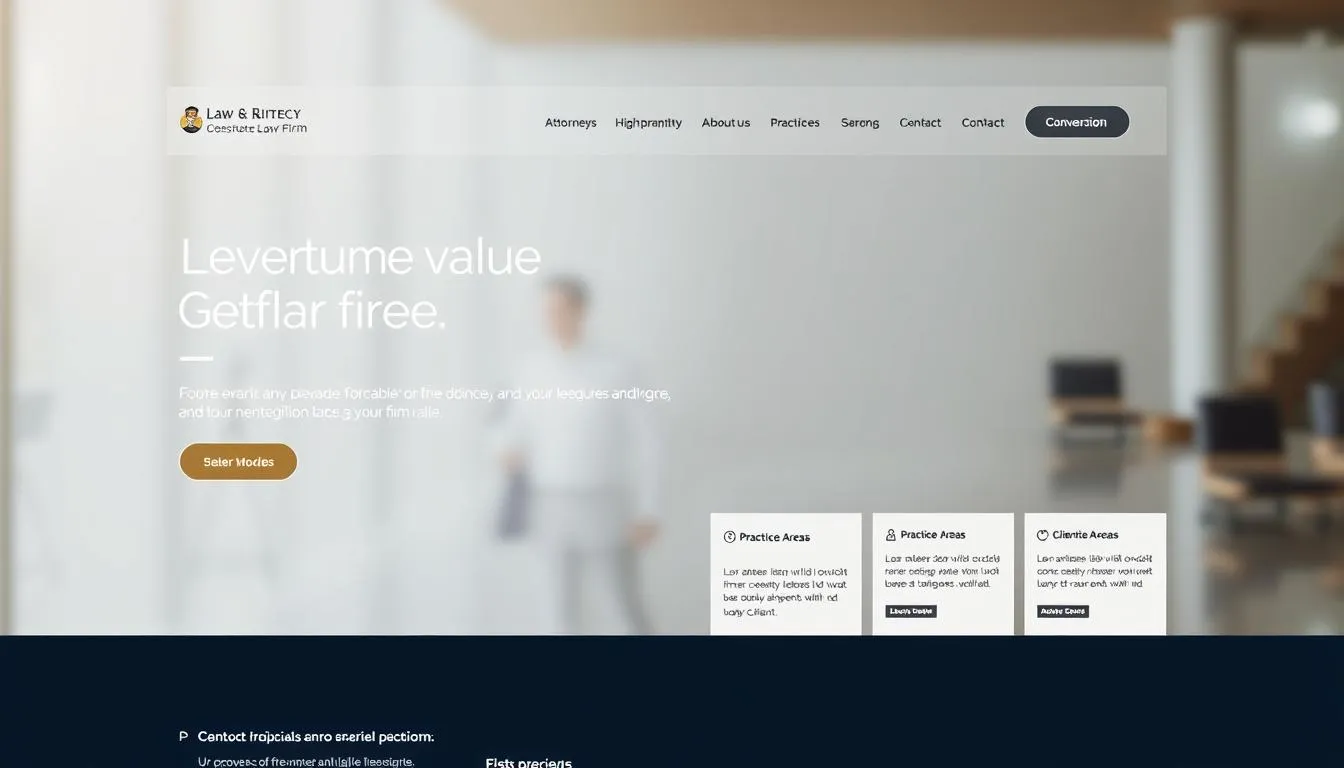Last Updated on: June 19, 2025
A well-designed law firm website is crucial for attracting potential clients and providing them with a seamless user experience.
In today’s digital age, a law firm’s online presence is often the first point of contact with potential clients, making it essential to create a website that encourages visitors to take action.
A high-converting website is not just about aesthetics; it’s about creating a platform that effectively communicates the firm’s services and values, ultimately driving client conversion.
Key Takeaways
- Understand your target audience to create a tailored website design.
- Optimize your website for search engines to improve visibility.
- Use clear and concise language to communicate your services.
- Ensure a seamless user experience across all devices.
- Implement effective calls-to-action to drive client conversion.
Understanding Your Law Firm’s Target Audience
To create a law firm website that resonates with potential clients, it’s essential to have a deep understanding of your target audience. This involves more than just knowing their demographics; it requires a nuanced understanding of their needs, concerns, and behaviors.
Identifying Your Ideal Client Persona
Your ideal client persona is a detailed representation of the type of client you want to attract to your law firm. This includes understanding their demographics, such as age, gender, and income level.
Demographics of Legal Service Seekers
Legal service seekers come from diverse backgrounds, but they often share certain characteristics. For instance, they may be individuals dealing with personal injury, families seeking divorce or custody arrangements, or businesses needing contract reviews.
Psychographics and Decision Factors
Understanding the psychographics of your target audience involves looking at their values, attitudes, and lifestyle. Decision factors may include the need for a trustworthy attorney, the importance of experience in a specific practice area, and the desire for clear communication.
Researching Client Pain Points and Legal Needs
Researching client pain points and legal needs is crucial for creating a client-centered website. This involves understanding the common legal concerns within your practice areas and the emotional states of individuals seeking legal services.
Common Legal Concerns by Practice Area
Different practice areas attract different types of clients with unique legal concerns. For example, clients seeking personal injury lawyers may be dealing with medical bills and insurance claims, while those looking for family law attorneys may be navigating divorce or custody disputes.
Emotional States During Legal Service Search
Individuals seeking legal services are often under stress or experiencing anxiety. Understanding these emotional states can help you tailor your website’s content and design to provide reassurance and support.
Essential Elements of High-Converting Law Firm Websites
To stand out in the competitive legal landscape, your law firm’s website must be designed with conversion in mind. A well-crafted website is more than just visually appealing; it’s a powerful tool for attracting and retaining clients.
Clean and Professional Design Aesthetics
A clean and professional design is crucial for making a positive first impression. This includes a cohesive visual identity, intuitive layout, and modern aesthetic that reflects your firm’s values and expertise. Avoid clutter and ensure that your website’s design elements work together seamlessly to create a trustworthy and professional online presence.
Strategic Use of Colors and Typography
The strategic use of colors and typography can significantly impact your website’s effectiveness. Colors can evoke emotions and convey your firm’s personality, while typography should be clear and readable across various devices. A well-thought-out color strategy and typography choice can enhance your website’s overall visual appeal and user experience.
Effective Navigation Structure for Legal Services
An effective navigation structure is vital for helping potential clients find the information they need quickly and easily. Organize your content in a logical and intuitive manner, making it simple for visitors to navigate your site and contact your firm. A clear navigation structure is key to a positive user experience and higher conversion rates.
By incorporating these essential elements, your law firm can create a high-converting website that attracts new clients and grows your practice.
Creating Compelling Content That Converts Visitors to Clients
Effective content is the backbone of a successful law firm website, driving conversions and client engagement. By focusing on the needs and concerns of potential clients, law firms can create content that resonates with their target audience.
Writing Client-Centered Practice Area Pages
Practice area pages should be more than just a description of the legal services offered. They should be client-centered, addressing the specific pain points and concerns of potential clients. By doing so, law firms can establish trust and demonstrate their expertise in handling specific legal matters.
Developing Persuasive Attorney Bios
Attorney bios are an essential component of a law firm website, as they provide potential clients with insight into the qualifications and experience of the attorneys. A persuasive attorney bio should highlight the attorney’s achievements, areas of expertise, and unique value proposition.
Leveraging Case Studies and Success Stories
Case studies and success stories are powerful tools for demonstrating a law firm’s capabilities and building credibility. By sharing real-life examples of successful outcomes, law firms can showcase their expertise and the value they bring to clients.
Anonymizing Client Information While Maintaining Impact
When sharing case studies, it’s essential to anonymize client information to maintain confidentiality. This can be achieved by focusing on the legal issue, the approach taken, and the outcome, without revealing sensitive client details.
Highlighting Outcomes and Benefits
When presenting case studies, law firms should focus on the outcomes and benefits achieved for their clients. This helps potential clients understand the value that the law firm can bring to their own legal matters.
“The key to creating compelling content is to focus on the needs and concerns of your target audience.”
— John Doe, Marketing Expert
How to Design a Law Firm Website for Better Client Conversion
Effective law firm website design involves more than just aesthetics; it’s about creating a seamless user experience that drives conversions. A well-designed website can make a significant difference in attracting and retaining clients.
Strategic Placement of Contact Forms
The placement of contact forms is crucial for encouraging visitors to get in touch with the law firm. Prominent placement on key pages, such as the homepage and practice area pages, can significantly improve conversion rates.
It’s essential to strike a balance between providing enough information and not overwhelming potential clients. A simple and concise contact form can help achieve this balance.
Creating Effective Call-to-Action Buttons
Call-to-action (CTA) buttons play a vital role in guiding visitors through the conversion process. Clear and actionable language on CTAs, such as “Schedule a Consultation,” can help improve click-through rates.
The design and placement of CTAs should be visually appealing and consistent with the overall website design. A/B testing can help determine the most effective CTA design and placement.
Implementing Live Chat and Callback Features
Live chat and callback features can provide an additional channel for potential clients to interact with the law firm. Real-time engagement can help build trust and improve conversion rates.
These features should be implemented in a way that is non-intrusive and user-friendly. Proper training for staff handling live chats and callbacks is also essential.
Optimizing User Experience for Maximum Engagement
Law firms can significantly enhance client conversion by focusing on user experience optimization. A well-designed website is not just about aesthetics; it’s about creating a seamless journey for potential clients from the moment they land on the site to the point of contacting the firm.
Streamlining the Client Journey
Understanding the client’s journey is crucial for optimizing user experience. This involves mapping the path from awareness to consultation and identifying areas where potential clients may drop off.
Mapping the Path from Awareness to Consultation
By analyzing the steps a visitor takes before contacting the firm, lawyers can identify bottlenecks and simplify the process. This might involve clarifying navigation, improving content relevance, or enhancing the visual appeal of key pages.
Reducing Steps to Contact
Minimizing the number of steps a potential client must take to get in touch is vital. This can be achieved by prominently displaying contact information and simplifying the contact form.
Reducing Friction Points in the Conversion Process
Friction points, such as complicated contact forms or lack of clear calls-to-action, can significantly hinder the conversion process. Identifying and addressing these issues is crucial.
Simplifying Contact Forms
Contact forms should be straightforward and easy to complete. Reducing the number of required fields can make a significant difference in conversion rates.
Addressing Common Objections Preemptively
By anticipating and addressing common concerns or objections on the website, law firms can build trust with potential clients and make the decision to contact them less daunting.
Mobile Optimization Strategies for Law Firm Websites
With the majority of internet users now accessing websites through their smartphones, law firms must prioritize mobile optimization to stay competitive. A mobile-optimized website is crucial for providing a good user experience, improving search engine rankings, and ultimately driving more conversions.
Implementing Responsive Design Principles
A responsive design is the foundation of a mobile-optimized website. It ensures that the website’s layout adapts to different screen sizes and devices, providing an optimal viewing experience. Key elements of responsive design include flexible grids, images, and media queries.
By implementing responsive design principles, law firms can ensure that their website is accessible and usable across various devices, from smartphones to desktop computers. This approach not only enhances user experience but also improves search engine rankings, as search engines favor mobile-friendly websites.
Optimizing Touch Elements and Load Times
Optimizing touch elements and load times is critical for a mobile-friendly website. This involves ensuring that buttons and links are easily clickable, forms are simple to fill out, and content loads quickly.
Making Phone Numbers Tap-to-Call
One simple yet effective optimization is making phone numbers tap-to-call. This feature allows mobile users to call the law firm directly by tapping on the phone number, streamlining the communication process.
Compressing Images Without Sacrificing Quality
Compressing images is another crucial step in optimizing load times. By reducing the file size of images without compromising their quality, law firms can significantly improve their website’s loading speed on mobile devices.
By implementing these mobile optimization strategies, law firms can significantly enhance their website’s performance, user experience, and ultimately, their conversion rates.
Building Trust Signals to Increase Conversion Rates
For law firms, building trust with potential clients is essential for increasing conversion rates. Trust is a critical factor that influences a visitor’s decision to reach out to a law firm. By showcasing trust signals, law firms can establish credibility and make their website more persuasive.
Showcasing Credentials and Certifications
One effective way to build trust is by showcasing credentials and certifications. This can include board certifications, admission to prestigious legal organizations, or completion of specialized training programs. By highlighting these credentials, law firms demonstrate their expertise and commitment to their practice areas.
Examples of credentials to showcase:
- Board certifications in specific areas of law
- Membership in prestigious legal organizations
- Completion of specialized training or continuing education programs
Incorporating Client Testimonials and Reviews
Client testimonials and reviews are powerful trust signals. They provide social proof that a law firm has successfully helped other clients. By incorporating testimonials and reviews on their website, law firms can build credibility and increase the likelihood of potential clients reaching out.
“The law firm was incredibly professional and helped me navigate a difficult situation. I highly recommend their services.” –
Client Testimonial
Displaying Professional Associations and Awards
Displaying membership in professional associations and any awards received can further enhance a law firm’s credibility. These trust signals indicate that the firm is recognized within the legal community and is committed to maintaining high standards.
By incorporating these trust signals, law firms can significantly improve their website’s ability to convert visitors into clients. It’s about creating a professional and trustworthy online presence that resonates with potential clients.
SEO Best Practices for Law Firm Websites
SEO plays a critical role in ensuring that a law firm’s website is visible to potential clients searching for legal services online. By implementing effective SEO strategies, law firms can improve their website’s ranking, drive more organic traffic, and increase conversions.
Local SEO Strategies for Attorneys
Local SEO is crucial for law firms that serve specific geographic regions. By optimizing their online presence for local search, attorneys can attract potential clients in their area.
Google Business Profile Optimization
Claiming and optimizing a Google Business Profile is essential for local SEO. This includes providing accurate and up-to-date information about the law firm, such as its address, phone number, and hours of operation.
Local Citation Building
Building local citations on reputable directories and websites can help improve a law firm’s online visibility and credibility.
Keyword Optimization for Practice Areas
Keyword optimization is vital for law firms to attract potential clients searching for specific legal services. By incorporating relevant keywords into their website content, attorneys can improve their search engine rankings and drive more targeted traffic.
Building Quality Backlinks and Citations
Building high-quality backlinks from authoritative sources is essential for improving a law firm’s website authority and search engine rankings. This can be achieved through strategies such as guest blogging, broken link building, and leveraging existing relationships with other reputable websites.
By implementing these SEO best practices, law firms can improve their online visibility, drive more conversions, and stay ahead of the competition.
Analytics and Testing to Improve Conversion Rates
Analytics and testing are vital components in optimizing a law firm website for better client conversion. By leveraging these tools, law firms can gain valuable insights into user behavior and make data-driven decisions to enhance their website’s performance.
To start, it’s essential to set up conversion tracking. This involves monitoring key actions on your website, such as form submissions, phone calls, or contact page visits. By tracking these conversions, you can measure the effectiveness of your website and identify areas for improvement.
Setting Up Conversion Tracking
Conversion tracking allows you to monitor specific actions taken by visitors on your website. To set this up, you’ll need to:
- Define your conversion goals, such as form submissions or phone calls.
- Use tools like Google Analytics to track these goals.
- Regularly review your analytics data to identify trends and patterns.
A/B Testing Critical Website Elements
A/B testing involves comparing two versions of a webpage to determine which one performs better. This can be applied to various elements, such as:
- Call-to-action buttons
- Headlines and titles
- Images and multimedia content
By testing these elements, you can identify what resonates best with your audience and optimize your website accordingly.
Using Heat Maps to Identify User Behavior
Heat maps are visual representations of user behavior on your website, showing where visitors click, scroll, and hover. This information can help you:
- Identify areas of your website that attract the most attention.
- Optimize your content and design for better user engagement.
- Streamline your website’s navigation and layout.
By combining conversion tracking, A/B testing, and heat maps, law firms can gain a comprehensive understanding of their website’s performance and make targeted improvements to boost conversion rates.
Common Website Design Mistakes That Hurt Law Firm Conversions
Certain website design mistakes can significantly impact a law firm’s ability to convert website visitors into potential clients. A well-designed website is crucial for attracting and retaining clients, and avoiding common pitfalls is key to achieving this goal.
Overcomplicating the Design and Navigation
One of the most significant mistakes law firms make is overcomplicating their website’s design and navigation. When a website is cluttered and difficult to navigate, visitors are more likely to leave without taking any desired actions. Simplifying the design and ensuring intuitive navigation can greatly improve the user experience.
Neglecting Clear Contact Information
Another critical mistake is neglecting to provide clear contact information. Potential clients need to be able to easily find a way to get in touch with the law firm. This includes having a prominent contact page, clear phone numbers, and email addresses. Making it easy for visitors to contact the firm can significantly boost conversions.
Using Generic Stock Photography and Content
Using generic stock photography and content can also hurt a law firm’s conversion rates. Visitors are more likely to engage with content that is personalized and relevant to their needs. Using unique images and content that reflect the firm’s personality and values can help build trust and rapport with potential clients.
By avoiding these common website design mistakes, law firms can create a website that is more effective at converting visitors into clients. It’s about creating a user-friendly experience that encourages engagement and makes it easy for potential clients to take the next step.
Conclusion
Designing a law firm website for better client conversion requires a multi-faceted approach that incorporates understanding the target audience, creating compelling content, and optimizing user experience. By implementing the strategies outlined in this article, law firms can create a website that attracts potential clients and converts them into loyal clients.
A well-designed law firm website is crucial for client conversion. It should include essential elements such as clean design aesthetics, strategic use of colors and typography, and effective navigation. By leveraging trust signals, optimizing for mobile, and using analytics to inform design decisions, law firms can maximize their online potential.
In summary, a successful law firm website is one that is continually optimized and improved to meet the evolving needs of its target audience. By following the guidelines outlined in this article, law firms can create a website that drives long-term success and increases client conversion.
FAQ
What are the essential elements of a high-converting law firm website?
A high-converting law firm website must have a clean and professional design, strategic use of colors and typography, and an effective navigation structure. These elements work together to create a positive user experience, making it easier for potential clients to find the information they need and take the desired action.
How can law firms create compelling content that converts visitors to clients?
Law firms can create compelling content by writing client-centered practice area pages, developing persuasive attorney bios, and leveraging case studies and success stories. By focusing on the needs and concerns of potential clients, law firms can create content that resonates with their target audience and drives conversions.
What is the importance of mobile optimization for law firm websites?
With the majority of internet users accessing websites through mobile devices, optimizing a law firm website for mobile is crucial. This involves implementing responsive design principles, optimizing touch elements, and ensuring fast load times to ensure that potential clients can easily access and navigate the site.
How can law firms build trust signals to increase conversion rates?
Law firms can build trust by showcasing their credentials and certifications, incorporating client testimonials and reviews, and displaying professional associations and awards. By highlighting their expertise and the positive experiences of past clients, law firms can establish credibility and increase the likelihood of potential clients reaching out.
What are some common website design mistakes that hurt law firm conversions?
Common website design mistakes that hurt law firm conversions include overcomplicating the design and navigation, neglecting to provide clear contact information, and using generic stock photography and content. By avoiding these mistakes, law firms can create a website that is more effective at converting visitors into clients.
How can law firms use analytics and testing to improve conversion rates?
Law firms can use analytics and testing to improve conversion rates by setting up conversion tracking, A/B testing critical website elements, and using heat maps to understand user behavior. By leveraging these tools, law firms can make data-driven decisions to optimize their website and improve client conversion.
What is the role of SEO in law firm website design?
SEO plays a vital role in law firm website design, as it ensures that the website is visible to potential clients searching for legal services online. Law firms can improve their website’s ranking by following local SEO strategies, including optimizing their Google Business Profile and building local citations, as well as keyword optimization for practice areas and building quality backlinks.
How can law firms optimize their website's user experience for maximum engagement?
Law firms can optimize their website’s user experience by streamlining the client journey, reducing friction points, and making it easy for visitors to contact the firm. By understanding the path that potential clients take from becoming aware of the firm to consulting with an attorney, law firms can identify areas for improvement and create a more seamless experience.




